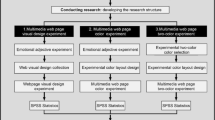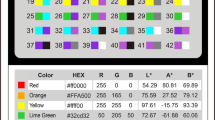Abstract
The visual language of a web page reflects its quality and emotion. Compared with static web page designs, dynamic web page designs enable easier reading and is more effective in attracting the attention of users. In this study, web pages were created using programs that applied three dynamic web page creation languages, namely HTML5, JavaScript, and CSS3. Moreover, the most suitable type of dynamic web page design was determined through experiments and analyses on diverse psychological feelings for web page composition and colors. Such experiments and analyses allow web page designers to understand users’ psychological factors more easily for developing the most suitable visual design for dynamic web pages. This study involved three parts: (1) understanding the status of current dynamic web page design, collecting HTML5 dynamic home pages of websites, and conducting experiments and analyses on web page contents; (2) exploring feelings regarding the use of websites and identifying optimized styles of dynamic web page design according to the compositions and dynamic representations of web images; and (3) developing superior color schemes for dynamic web page design and providing a reference for applying colors to dynamic web page design. The research results indicated that the design covered entirely with carousel images when the home page remained static had the best visual effect, followed by the design containing carousel images and 1/10th area of blank space to the left and right sides of the images when the home page remained static. The affective adjective pair with the best fit in the experiments was difficult–convenient, followed by trivial–simple and annoying–favorite. The most popular color for dynamic web pages was dark royal blue (L46.8, A17.8, and B-66.7), followed by dark cyan (L36.2, A-39.9, and B40.8). The results obtained through experiments on dynamic web pages in this study serve as a reference for web designers and researchers to configure the composition and colors of dynamic web page design.










Similar content being viewed by others
Data availability
Sources such as research data (data) were completed through questionnaires, Google statistics tables, and SPSS statistical software statistics. If the journal accepts the article, you can get the raw data with the appropriate author.
References
Alexandra T, Melissa G, Frans F (2020) The effect of packaging color and health claims on product attitude and buying intention. Int J Environ Res Publ Health 17:1991. https://doi.org/10.3390/ijerph17061991
Andrey K (2018) Large-scale holistic approach to Web block classification: assembling the jigsaws of a Web page puzzle. World Wide Web 22:1999-2015. https://doi.org/10.1007/s11280-018-0634-6
Azman SA (2020) Color in packaging / Shahrul Azmeer Azman. J Art Des (REKA) 2:17–19
Berlyne DE (1971) Information, uncertainty, redundancy, aesthetics and psychobiology. Meredith Corporation, New York
Birnbaum,Chapter MH (2000) Decision making in the lab and on the web. In: Birnbaum MH (eds) Psychological Experiments on the Internet. Academic, Cambridge, pp 3-34. https://doi.org/10.1016/B978-012099980-4/50002-2
Bodrunova SS, Yakunin AV (2017) U-index: An Eye-Tracking-Tested Checklist on Webpage Aesthetics for University Web Spaces in Russia and the USA. In: Marcus A, Wang W (eds) Design, User Experience, and Usability: Theory, Methodology, and Management. DUXU 2017, vol 10288. Springer, Cham. https://doi.org/10.1007/978-3-319-58634-2_17
Bonnardel N, Piolat A, Le Bigot L (2011) The impact of colour on website appeal and users’ cognitive processes. Displays 32:69–80. https://doi.org/10.1016/j.displa.2010.12.002
Calvo RA, Mello SD (2010) Affect detection: an interdisciplinary review of models, methods, and their applications. IEEE Trans Affect Comput 1:18–37
Carrion B, Onorati T, Díaz P, Triga V (2019) A taxonomy generation tool for semantic visual analysis of large corpus of documents. Multimed Tools Appl 78:32919–32937. https://doi.org/10.1007/s11042-019-07880-y
Demir Ü (2020) Investigation of color-emotion associations of the university students. Color Res Appl 45(5):871–884. https://doi.org/10.1002/col.22522
Deng L (2006) Beyond usability: affect in web browsing. Unpublished doctoral dissertation, Texas A&M University, Texas
Derefeldt G, Swartling T (1995) Colour concept retrieval by free colour naming: identification of up to 30 colours without training. Displays 16:69–77. https://doi.org/10.1016/0141-938/2895/991176-3
Eroglu SA, Machleit KA, Davis LM (2003) Empirical testing of a model of online store atmospherics and shopper responses. Psychol Market 20:139–150. https://doi.org/10.1002/mar.10064
Fabien C (2011) Timesheets.js: when SMIL meets HTML5 and CSS3.DocEng ‘11: Proceedings of the 11th ACM Symposium on Document Engineering, pp 43–52, https://doi.org/10.1145/2034691.2034700
Furche T, Gottlob G, Grasso G, Gunes O, Guo X, Kravchenko A, Orsi G, Schallhart C, Sellers AJ, Wang C (2012) DIADEM: domain-centric, intelligent, automated data extraction methodology. WWW '12 Companion: Proceedings of the 21st International Conference on World Wide Web p 267
Gasparini F, Giltri M, Bandini S (2020) Discriminating affective state intensity using physiological responses. Multimed Tools Appl 79:35845–35865. https://doi.org/10.1007/s11042-020-09114-y10/1272641872095375360
Guan S, Lin Y (2002) A study of generating the web design system based on the Kansei engineering process. J Des 7:59–74
Hashemi M (2020) Web page classification: a survey of perspectives, gaps, and future directions. Multimed Tools Appl 79:11921–11945
Hu R, Yan Z, Ding W, Yang LT (2020) A survey on data provenance in IoT. World Wide Web 23:1441–1463
Iman Dianat P, Adeli MA, Jafarabadi MA Karimi (2019) User-centred web design, usability and user satisfaction. The case of online banking websites in Iran. Appl Ergon 81:102892
Jennings M (2000) Theory and models for creating engaging and immersive ecommerce websites. In: Special Interest Group on Computer Personnel Research Annual Conference. ACM Press, New York
Jeong SH, Lee KP (2005) Extraction of user’s representative emotions expressed white using a product. J Korean Soc Des Sci 18:69–80
Kallio T (2003) Why we choose the more attractive looking objects: somatic markers and somaesthetics in user experience. In: Proceedings of the 2003 International Conference on Designing Pleasurable Products and Interfaces. ACM Press, New York
Kang J, Choi J (2008) Block classification of a Web page by using a combination of multiple classifiers. In: Fourth International Conference on Networked Computing and Advanced Information Management
Kesler Tanner N, Johnson JA, Landay (2019) CHI ‘19: Proceedings of the 2019 CHI Conference on Human Factors in Computing Systems. 528, 1-12
Kovač A, Kovačević D, Bota J, Brozović M (2019) Consumers’ preferences for visual elements on chocolate packaging. J Graph Eng Des 10:13–18. https://doi.org/10.24867/JGED-2019-1-013
Krishnan A, Deepak P, Sayan R, Sameep M (2018) Leveraging semantic resources in diversified query expansion. World Wide Web 21:1041–1067. https://doi.org/10.1007/s11280-018-0634-6
Kuo L, Chang T, Lai C-C( (2021) Visual effect and color matching of dynamic image webpage design. Color Res Appl 2021:1–11. https://doi.org/10.1002/col.22662
Lin H (2014) Red-colored products enhance the attractiveness of women. Displays 35:202–205. https://doi.org/10.1016/j.displa.2014.05.009
Liu Y (2000) The aesthetics and the ethic dimensions of human factors and design. Ergonomics 46:1293–1305
Ma Y, Guangrong D (2020) Application of computer image processing technology in Web Design. 2020 2nd International Conference on Information Technology and Computer Application (ITCA), 125-127. https://doi.org/10.1109/ITCA52113.2020.00033
Majumdar A, Shrivastava A, Lee S, Anderson P, Parikh D, Batra D (2020) Improving Vision-and-Language Navigation with Image-Text Pairs from the Web. In: Vedaldi A, Bischof H, Brox T, Frahm JM (eds) Computer Vision – ECCV 2020. ECCV 2020, vol 12351. Springer, Cham. https://doi.org/10.1007/978-3-030-58539-6_16
Mikkonen T, Taivalsaari A (2008) Web applications- spaghetti code for the 21st century. In: 6th International Conference in Software, Engineering, Research, Management and Applications (SERA’08), pp 319-328
Musiał K, Kazienko P (2013) Social networks on the Internet. World Wide Web 16:31–72
Nathalie B, Annie P, Ludovic Le B (2011) The impact of colour on website appeal and users’ cognitive processes. Displays 32:60–82. https://doi.org/10.1016/j.displa.2010.12.002
Nielsen J (1993) Usability engineering. Academic, Cambridge, p 224
Norman DA (2000) Design psychology-user-centered, safe and easy-to-use design principles of daily necessities (translation by Cho Y.). Yuanliu Publishing, Taipei
Nusrat JS, Ang LM, Kah P, Rahaman DMM, Zia T (2020) Multimodal big data affective analytics: a comprehensive survey using text, audio, visual and physiological signals. J Network Comput Appl 149:102447. https://doi.org/10.1016/j.jnca.2019.102447
Oliva A, Mack ML, Shrestha M, Peeper A (2004) Identifying the perceptual dimensions of visual complexity of scenes. In: Paper Presented at the 26th Annual Meeting of the Cognitive Science Society, Chicago
Pak A, Paroubek P (2010) Twitter as a corpus for sentiment analysis and opinionmining. In: Proceedings of the Seventh Conference on International Language Resources and Evaluation, pp 1320-1326
Pan Y, He F, Yu H (2020) Learning social representations with deep autoencoder for recommender system. World Wide Web 23:2259–2279. https://doi.org/10.1007/s11280-020-00793-z
Pollet TV, Costello J, Groeneboom L, Peperkoorn LS, Wu J (2019) Dored objects enhance sexual attractiveness? No evidence from two large replications. Displays 56:23–29. https://doi.org/10.1016/j.displa.2018.10.008
Poria S, Cambria E, Howard N, Huang GB, Hussain A (2016) Fusing audio, visual and textual clues for sentiment analysis from multimodal content. Neurocomputing 174:50–59. https://doi.org/10.1016/j.neucom.2015.01.095
Rinaldi AM, Russo C (2020) Using a multimedia semantic graph for web document visualization and arization. Multimed Tools Appl. https://doi.org/10.1007/s11042-020-09761-1
Rodriguez-Gil L, Orduña P, García-Zubia J, López-de-Ipiña D (2018) Interactive live-streaming technologies and approaches for web-based applications. Multimed Tools Appl 77:6471–6502. https://doi.org/10.1007/s11042-017-4556-6
Rubens PM (1986) A reader’s view of text and graphics: implications for transactional text. J Techn Writ Commun 16:73–86
Saragih JM, Lucey S, Cohn JF (2009) Face alignment through subspace constrainedmean-shifts. In: 2009 IEEE 12th International Conference on Computer Vision. IEEE, pp 1034-1041
Schubert TW, Murteira C, Collins EC, Lopes D (2013) ScriptingRT: a software library for collecting response latencies in online studies of cognition. PLoS ONE 8:e67769. https://doi.org/10.1371/journal.pone.0067769
Speriosu M, Sudan N, Upadhyay S, Baldridge J (2011) Twitter polarity classification with label propagation over lexical links and the follower graph. In: Proceedings of the Conference on Empirical Methods in Natural Language Processing, pp 53-56
Sutcliffe A (2003) Multimedia user interface design. In: Sears A, Jacko JA (eds) Human-computer interaction handbook-fundamentals, evolving technologies and emerging applications. CRC Press, Boca Raton, pp 35–51
Tractinsky N, Cokhavi A, Kirschenbaum M (2004) Using ratings and response latencies to evaluate the consistency of immediate aesthetic perceptions of web pages. In: Proceedings of the Third Annual Workshop on HCI Research in MIS. Washington, DC, pp 1-5
Tractinsky N, Cokhavi A, Kirschenbaum M, Sharfi T (2006) Evaluating the consistency of immediate aesthetic perception of web pages. Int J Hum Comput Stud 64:1071–1083. https://doi.org/10.1016/j.ijhcs.2006.06.009
Tsou MH et al (2017) Building a Real-Time Geo-Targeted Event Observation (Geo) viewer for disaster management and situation awareness. In: Peterson M et al (eds) Advances in Cartography and GIScience. ICACI 2017. Lecture Notes in Geoinformation and Cartography. Springer, Cham. https://doi.org/10.1007/978-3-319-57336-6_7
Vuorimaa P, Laine M, Litvinova E, Shestakov D (2016) Leveraging declarative languages in web application development. World Wide Web 19:519–543
Wischenbart M, Firmenich S, Rossi G et al (2021) Engaging end-user driven recommender systems: personalization through web augmentation. Multimed Tools Appl 80:6785–6809. https://doi.org/10.1007/s11042-020-09803-8
Wu Y, He F, Zhang D, Li X (2018) Service-oriented feature-based data exchange for cloud-based design and manufacturing. IEEE Trans Serv Comput 11:341–353. https://doi.org/10.1109/TSC.2015.2501981
Yu H, He F, Pan Y (2020) A scalable region-based level set method using adaptive bilateral filter for noisy image segmentation. Multimed Tools Appl 79:5743–5765. https://doi.org/10.1007/s11042-019-08493-1
Funding
Sanming University.
Research Foundation for Advanced Talents, Grant Number: 21YG02S. Supported by Fujian Province Science, Grant Number: FJ2021B190.
Author information
Authors and Affiliations
Contributions
Although this study adopted dynamic web pages on tourist landscape in the experiments, the experimental results provide a theoretical and practical reference for the selection of appropriate colors and design styles for tourism websites and web pages of other product types. This research acts as a reference for web design researchers and website designers.
Corresponding author
Ethics declarations
Conflicts of interest/Competing interests
There are no conflicts of interest in the content of this article.
Additional information
Publisher’s Note
Springer Nature remains neutral with regard to jurisdictional claims in published maps and institutional affiliations.
Rights and permissions
About this article
Cite this article
Kuo, L., Chang, T. & Lai, CC. Application of visual colors in dynamic web page design through affective cognition. Multimed Tools Appl 81, 4435–4454 (2022). https://doi.org/10.1007/s11042-021-11732-z
Received:
Revised:
Accepted:
Published:
Issue Date:
DOI: https://doi.org/10.1007/s11042-021-11732-z




